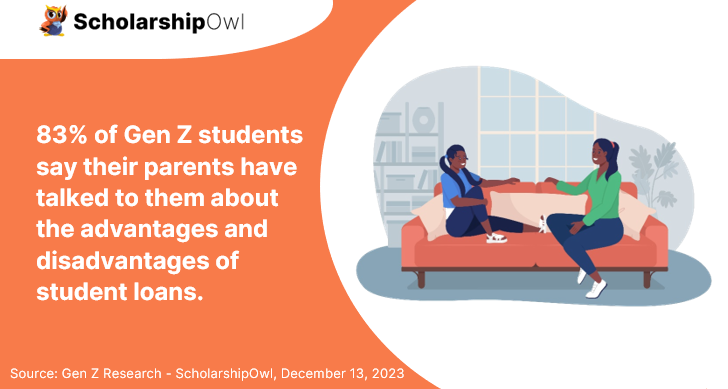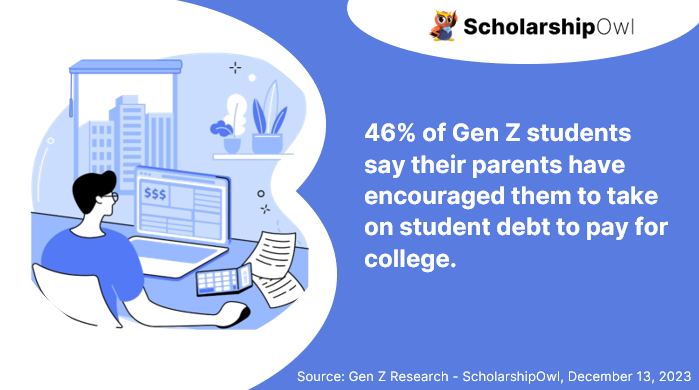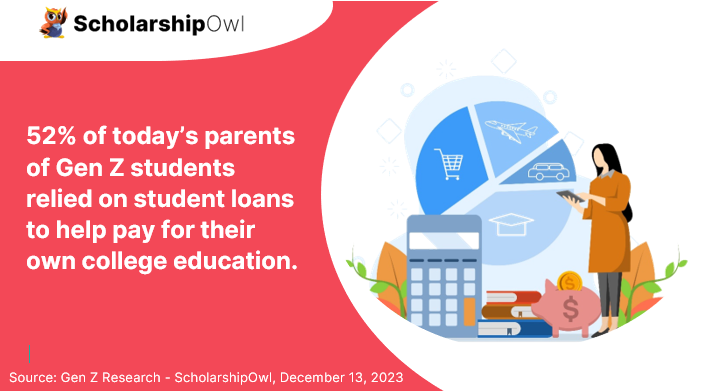Thank you for subscribing!
scholarship owl conducts a monthly survey to better understand how Gen Z views college, scholarships, financial aid, and the future. In November, we asked students about what they learned about student loans from their parents and assessed how this influenced their decisions about whether to take out student loans. Although 83% of respondents said their parents have discussed the pros and cons of student loans, the overwhelming majority still plan to graduate with student loans. Most strikingly, 88% of respondents graduated with debt, compared to just 52% of their parents who had to do the same.

Who participated in the survey?
In November 2023, ScholarshipOwl surveyed high school and college students on the ScholarshipOwl scholarship platform to learn more about their opinions on the value of college. A total of 6,545 students responded.
Of the respondents, 62% were female, 36% were male, and 2% identified themselves as other. Nearly half (49%) identified as white, 21% as black, 16% as Hispanic/Latino, 6% as Asian/Pacific Islander, and 6% as other.
More than half of the respondents (58%) were high school students; More than a third (34%) were undergraduate students, primarily first and second years of college. 5% were graduate students and 3% identified themselves as adult/nontraditional students.
survey questions
Question 1
We began our survey by asking students, “Have your parents told you about the pros and cons of student loans?” The overwhelming majority (83%) said yes, but less than a fifth (17%) said no.

Question 2
The next question was, “Did your parents encourage you to take out student loans to pay for college?” Almost half of the students (46%) said yes and just over half (54%) said no.

Question 3
We wanted to know how these conversations with parents influence students’ decisions about student loans. We asked our students, “How much student loan debt do you expect to have after completing your college education?” Overall, 88% of respondents expect to graduate with some level of student loan debt. Full breakdown:
- 16% expect to graduate with up to $10,000 in student loans
- 14% expect to graduate with between $10,001 and $20,000 in student loans
- 12% expect to graduate with between $20,001 and $30,000 in student loans
- 9% expect to graduate with between $30,001 and $40,000 in student loans
- 8% expect to graduate with between $40,001 and $50,000 in student loans
- 7% expect to graduate with between $50,001 and $60,000 in student loans
- 7% expect to graduate with between $60,001 and $80,000 in student loans
- 6% expect to graduate with between $80,001 and $100,000 in student loans
- 8% expect to graduate with more than $100,000 in student loans
- Only 12% said they would not graduate with student debt

Question 4
The final question was, “If your parents attended college, did they graduate with student loans?” Of all students surveyed, 5,232 (66%) said their parents had attended college. Of these students, 52% said their parents graduated with student loans, while 26% said no. Some respondents (13%) were unsure if their parent graduated with student loans.

Important points
The good news is that an overwhelming majority (83%) of parents talk to their kids about the pros and cons of student loans, but nearly half (46%) of those parents say they don’t want their kids to take out a student loan. I’m disappointed when I see people recommending this. Student loans to pay for college tuition. Among those surveyed whose parents attended college, only about half (52%) graduated with student loans, but 88% of students surveyed had student loans. I expect that I will graduate. Although these results are disappointing, they are not surprising. According to Georgetown University 2021 ResearchUniversity tuition has increased by 169% since 1980, yet incomes for young people between the ages of 22 and 27 have increased by only 19%.
Research conducted by Economic Policy Research Institute This shows that wages have stagnated since the 1970s. Since 1979, wages for middle-income earners have increased by only 6%, and wages for low-income earners have actually fallen by 5%. However, the highest paying companies saw a 41% increase, which is clearly evidenced by the fact that CEOs earn 296 times more than the typical employee in their industry.
While it’s positive that parents are helping to educate their children about the pros and cons of student loans, parents are also learning how to forge an affordable path to college: taking on student loans. We also need to help children understand the path that does not include.
How can students go to college without taking on student loans?
Instead of taking out student loans, students can use debt-free sources to pay for college.
- To access federal and state grant aid, FAFSA.
- Prioritize scholarship applications scholarship owl.
- Work part-time during the school year and full-time during breaks. Use the money you earn to pay for your college education.
- Choose a more affordable option for attending college, such as starting at a community college.
Parents and school counselors should encourage students to apply for scholarships and jobs rather than loans so that they can graduate debt-free. There is an affordable path to college – for more information and to start applying for a scholarship, visit: www.scholarshipowl.com.




